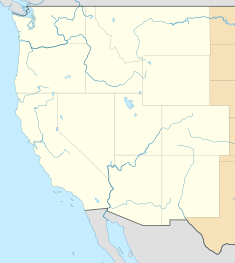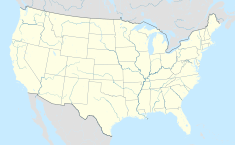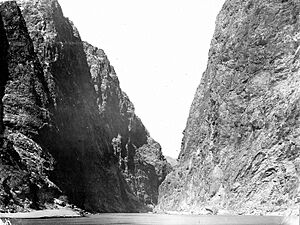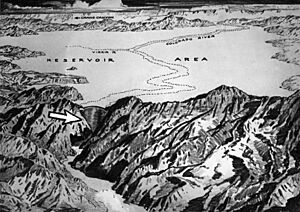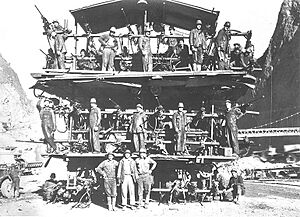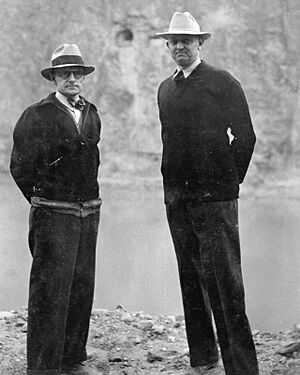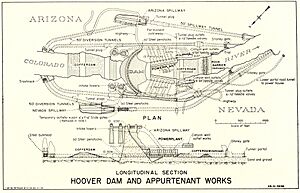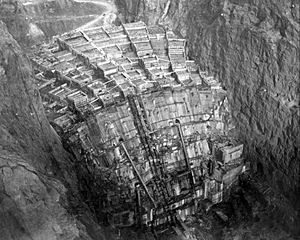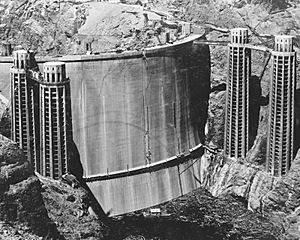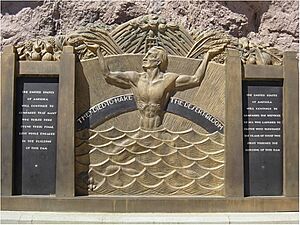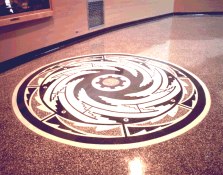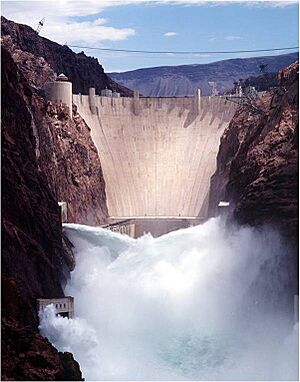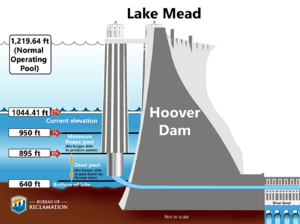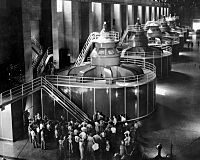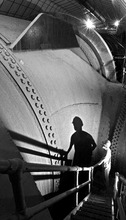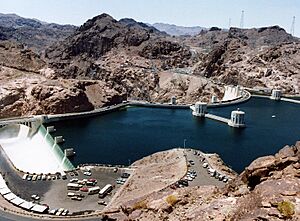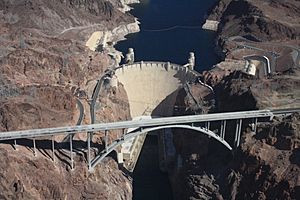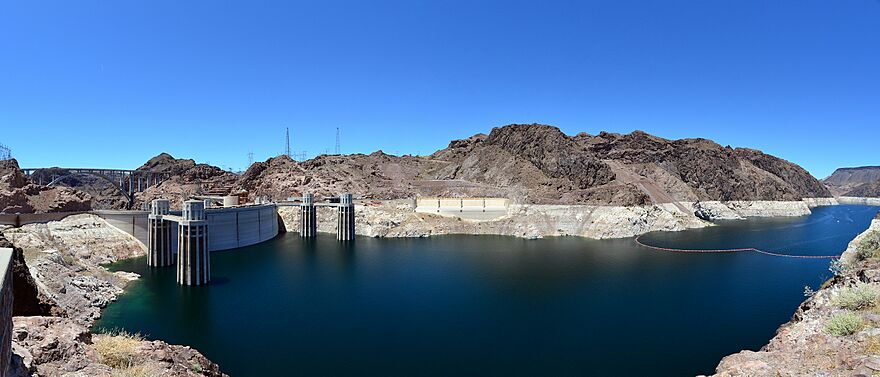Hoover Dam facts for kids
Quick facts for kids Hoover Dam |
|
|---|---|
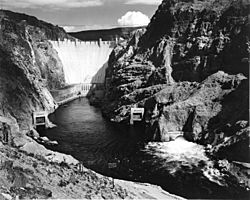
Hoover Dam by Ansel Adams, 1941
|
|
| Official name | Hoover Dam |
| Location | Clark County, Nevada/Mohave County, Arizona, U.S. |
| Purpose | Power, flood control, water storage, regulation, recreation |
| Status | Operational |
| Construction began | 1931 |
| Opening date | 1936 |
| Construction cost | $49 million (1931 budget) ($713 million in 2021 dollars ) |
| Owner(s) | United States government |
| Operator(s) | U.S. Bureau of Reclamation |
| Dam and spillways | |
| Type of dam | Concrete gravity-arch dam |
| Impounds | Colorado River |
| Height | 726.4 ft (221.4 m) |
| Length | 1,244 ft (379 m) |
| Elevation at crest | 1,232 ft (376 m) |
| Width (crest) | 45 ft (14 m) |
| Width (base) | 660 ft (200 m) |
| Dam volume | 3,250,000 cu yd (2,480,000 m3) |
| Spillway type | 2 controlled Drum-Gate, Side channel |
| Spillway capacity | 400,000 cu ft/s (11,000 m3/s) |
| Reservoir | |
| Creates | Lake Mead |
| Total capacity | 28,537,000 acre⋅ft (35.200 km3) |
| Active capacity | 15,853,000 acre⋅ft (19.554 km3) |
| Inactive capacity | 10,024,000 acre⋅ft (12.364 km3) |
| Catchment area | 167,800 sq mi (435,000 km2) |
| Surface area | 247 sq mi (640 km2) |
| Maximum length | 112 mi (180 km) |
| Maximum water depth | 590 ft (180 m) |
| Normal elevation | 1,219 ft (372 m) |
| Power station | |
| Operator(s) | U.S. Bureau of Reclamation |
| Commission date | 1936–1960 |
| Hydraulic head | 590 ft (180 m) (Max) |
| Turbines |
|
| Installed capacity | 2,078.8 MW |
| Capacity factor | 23% |
| Annual generation | 3.3 TWh (12 PJ) (2020) |
| Website Bureau of Reclamation: Lower Colorado Region - Hoover Dam |
|
|
Hoover Dam
|
|
 |
|
| Nearest city | Boulder City, Nevada |
| Built | 1933 |
| Architect | Six Companies, Inc. (structural), Gordon Kaufmann (exteriors) |
| Architectural style | Art Deco |
| MPS | Vehicular Bridges in Arizona MPS (AD) |
| NRHP reference No. | 81000382 |
| Significant dates | |
| First Power Generation | September 11, 1936 |
| Added to NRHP | April 8, 1981 |
| Designated NHL | August 20, 1985 |
The Hoover Dam is a huge concrete dam built in the Black Canyon of the Colorado River. It sits on the border between Nevada and Arizona. This amazing structure was built between 1931 and 1936, during a tough time called the Great Depression.
President Franklin D. Roosevelt officially opened the dam on September 30, 1935. Building it was a massive project that needed thousands of workers. Sadly, over 100 lives were lost during its construction. Congress first named it Hoover Dam after President Herbert Hoover. But the Roosevelt government later called it Boulder Dam. In 1947, Congress changed the name back to Hoover Dam.
For many years, people looked at Black Canyon and nearby Boulder Canyon as places to build a dam. They wanted to control floods, provide water for farms, and make hydroelectric power (electricity from water). In 1928, Congress approved the project. A group of companies called Six Companies, Inc. won the bid to build the dam. They started work in early 1931. No one had ever built such a large concrete structure before. The hot summer weather and lack of nearby facilities made the job very hard. Even so, Six Companies finished the dam more than two years early, handing it over to the government on March 1, 1936.
Hoover Dam creates Lake Mead, a huge reservoir. It is located near Boulder City, Nevada, a town built just for the dam workers. This town is about 30 mi (48 km) southeast of Las Vegas, Nevada. The dam's generators provide electricity to homes and businesses in Nevada, Arizona, and California. Hoover Dam is also a very popular place to visit, attracting about 7 million tourists each year. Until 2010, the busy U.S. Route 93 went right over the dam. Now, the Hoover Dam Bypass helps traffic go around it.
Contents
Why Was Hoover Dam Built?
Looking for Water and Power
As the United States grew, especially in the Southwest, the Colorado River became important. People saw it as a great source of water for farming. In the late 1890s, a man named William Beatty tried to use the river to water the Imperial Valley. He built the Alamo Canal, which went into Mexico. This canal helped many people settle the valley. But it was expensive to run.
Later, as ways to send electricity over long distances got better, people thought about using the Lower Colorado River to make hydroelectric power. In 1902, the Edison Electric Company looked at the river. They hoped to build a dam that could make a lot of power. But back then, electricity could only travel about 80 miles (130 km). There weren't many customers nearby, so Edison didn't pursue the idea.
The Bureau of Reclamation (BOR), which plans water projects, also thought about building a dam on the Lower Colorado. Their chief, Arthur Powell Davis, even suggested using dynamite to collapse canyon walls into the river to form a dam. But in 1922, they decided this idea was too risky and might not save money.
Planning the Big Project
In 1922, the Bureau of Reclamation suggested building a dam on the Colorado River. This dam would control floods and make electricity. The report said the river was important to many states and even Mexico. The report suggested a dam "at or near Boulder Canyon." But the Bureau found that Boulder Canyon wasn't the best spot. One part had a geologic fault (a crack in the earth). Other spots were too narrow for a construction camp or a spillway.
They then looked at Black Canyon and found it perfect. A railway could be built from Las Vegas right to the dam site. Even though the location changed, the project was still called the "Boulder Canyon Project."
Many states shared the Colorado River. To avoid arguments over water, a lawyer named Delph Carpenter suggested that the seven states in the river's basin (California, Nevada, Arizona, Utah, New Mexico, Colorado, and Wyoming) make an agreement. This was a new idea for so many states. In 1922, representatives from these states met with Secretary of Commerce Herbert Hoover. They finally signed the Colorado River Compact on November 24, 1922. This agreement helped decide how the water would be shared.
Getting Congress to approve the dam was hard. Many thought it was too expensive and would only help California. But a big flood in Mississippi in 1927 made other lawmakers more understanding. Then, in 1928, the St. Francis Dam in Los Angeles broke, causing a terrible flood that killed many people. Some worried the Black Canyon dam, which was similar, might also be unsafe. Congress asked engineers to check the plans. They said the dam was possible but warned that if it failed, everything downstream would be destroyed. They said the dam must be built very carefully.
Finally, on December 21, 1928, President Coolidge signed the bill to approve the dam. The project would cost $165 million. It also included other projects like the Imperial Dam. The agreement among the states could start once six of the seven states approved it. Utah approved it in 1929, making the agreement official. Arizona didn't approve it until 1944.
Designing and Planning the Dam
Even before Congress approved the project, the Bureau of Reclamation was thinking about the dam's design. They chose a huge concrete arch-gravity dam. This design was led by chief engineer John L. Savage. The dam would be very thick at the bottom and thinner at the top. It would curve towards the water, pushing the water's force into the canyon walls. The dam would be 660 ft (200 m) thick at the bottom and 45 ft (14 m) at the top. This top part would have a highway connecting Nevada and Arizona.
In January 1931, the Bureau released the plans for companies to bid on. The government would provide materials. The winning company would prepare the site and build the dam. The plans were very detailed, with 100 pages of text and 76 drawings. The company had seven years to build the dam.
The Wattis Brothers from the Utah Construction Company wanted to bid. But they didn't have enough money. So, they teamed up with other companies like Morrison-Knudsen and Henry J. Kaiser. This group was called Six Companies, Inc.. Their bid of $48,890,955 was the lowest. It was very close to the government's secret estimate and much lower than other bids.
The city of Las Vegas wanted to be the main base for the dam's construction. But in 1930, Secretary of the Interior Ray Wilbur announced that a new city would be built near the dam site. This city became Boulder City, Nevada. Work on a railway connecting Las Vegas to the dam site began in September 1930.
Building the Dam
The Workers
After the dam was approved, many jobless people came to southern Nevada. Las Vegas, a small city of 5,000, suddenly had 10,000 to 20,000 unemployed people. A government camp was set up near the dam. Soon, it was surrounded by a camp of people hoping for work. This camp was called McKeeversville. Another camp by the river was called "Ragtown."
When construction started, Six Companies hired many workers. By 1932, over 3,000 people worked there. At its peak in 1934, there were 5,251 workers. The contract did not allow Chinese workers. Very few black workers were hired, and they were in separate, low-paying groups.
Six Companies was supposed to build Boulder City for the workers. But President Hoover wanted work on the dam to start early, in March 1931. So, the company built bunkhouses for 480 single men at River Camp. Workers with families had to find their own places until Boulder City was ready. Many lived in Ragtown. The dam site gets extremely hot. In the summer of 1931, the average daytime high was 119.9 °F (48.8 °C). Sixteen workers died from heatstroke that summer.
Some workers tried to form a union to get better conditions. They sent their demands to Frank Crowe, the general superintendent. He was not helpful. On August 9, 1931, Crowe told the workers that management refused their demands. He said all work would stop, and everyone would be laid off. Most workers left for Las Vegas. Two days later, the rest left too. On August 13, the company started hiring again. The strike ended, and workers got none of their demands. But the company promised no more wage cuts. Living conditions slowly got better as people moved into Boulder City in late 1931.
Changing the River's Path
Before building the dam, the Colorado River had to be moved away from the construction area. To do this, four large tunnels were dug through the canyon walls. Two tunnels were on the Nevada side, and two were on the Arizona side. These tunnels were 56 ft (17 m) wide and over 3 miles (5 km) long combined. The company had a strict deadline for these tunnels.
Tunneling began in May 1931. By March 1932, workers started lining the tunnels with concrete. The concrete lining was 3 feet (1 m) thick, making the finished tunnels 50 ft (15 m) wide. On November 13, 1932, the river was sent into the two Arizona tunnels. This was done by blowing up a temporary dam and dumping rocks into the river to block its natural path.
After the dam was finished, the entrances to the outer tunnels were sealed with concrete. The inner tunnels now carry large steel pipes. These pipes connect the intake towers to the power plant.
Preparing the Ground
To protect the construction site from the Colorado River, two temporary dams called cofferdams were built. Work on the first cofferdam started in September 1932. These dams were designed to protect thousands of workers. The upper cofferdam was 96 ft (29 m) high and 750 feet (230 m) thick at its base. It was even thicker than the dam itself!
Once the cofferdams were in place and the site was dry, workers started digging the dam's foundation. They had to remove all loose soil and rocks until they reached solid bedrock. This work finished in June 1933. About 1,500,000 cu yd (1,100,000 m3) of material was removed. Since the dam would push against the canyon walls, these walls also had to be dug out to reach strong rock.
The workers who removed loose rock from the canyon walls were called "high scalers." They hung from ropes high above the river. They used jackhammers and dynamite to clear the rock. Falling objects were a big danger at the dam site. The high scalers' work helped keep everyone safer. They even became a tourist attraction, showing off for the crowds. To protect themselves, some high scalers dipped cloth hats in tar to make them hard. These were the first "hard hats"!
The rock foundation was also strengthened with grout (a type of cement mixture). Holes were drilled into the canyon walls and base, up to 150 feet (46 m) deep. Any empty spaces found were filled with grout. This made the rock stable and stopped water from leaking under or around the dam.
Pouring the Concrete
The first concrete was poured into the dam on June 6, 1933. This was 18 months ahead of schedule! Concrete gets hot and shrinks as it dries. If the dam was built in one big pour, it would take 125 years to cool. This would cause cracks. So, engineers divided the dam's base into rectangles. They poured concrete in huge blocks, some as big as 50 ft square (15 m) and 5 feet (1.5 m) high.
Each block had 1-inch (25 mm) steel pipes inside. Cool river water, then ice-cold water from a cooling plant, was pumped through these pipes. This helped the concrete cool down faster. Once a block was dry and stopped shrinking, the pipes were filled with grout. Grout also filled the tiny gaps between the blocks, which were grooved to make the dam stronger.
The concrete was brought in huge steel buckets, 7 feet high (2.1 m) and almost 7 feet wide. These buckets weighed 20 short tons (18.1 t; 17.9 long tons) when full. They were filled at two large concrete plants on the Nevada side. Special trains brought them to the site. Then, aerial cableways moved the buckets to the right spot. When a bucket opened, it dropped 8 cu yd (6.1 m3) of concrete. Workers then spread it evenly. There are stories that workers were trapped in the concrete, but this is a myth. Each pour only added about 1 inch (25 mm) to the concrete's depth.
A total of 3,250,000 cubic yards (2,480,000 cubic meters) of concrete was used in the dam itself. Another 1,110,000 cu yd (850,000 m3) was used for the power plant and other structures. There is enough concrete in the dam to pave a two-lane highway from San Francisco to New York! Tests in 1995 showed that the dam's concrete is still getting stronger.
Opening Day and Finishing Touches
Most of the dam was finished (the power plant was still being built). So, a special opening ceremony was held on September 30, 1935. President Franklin D. Roosevelt attended. The ceremony time was changed at the last minute, but 10,000 people still came despite the 102 °F (39 °C) heat. President Roosevelt gave a speech but did not mention former President Hoover. A special three-cent stamp was made for the event, calling it "Boulder Dam." After the ceremony, Roosevelt visited Las Vegas.
Six Companies worked with the government to finish everything and officially hand over the dam. On March 1, 1936, Secretary of the Interior Harold L. Ickes officially accepted the dam for the government.
Construction Deaths
There were 112 deaths linked to the dam's construction. The first was Harold Connelly, who died in 1921 while surveying the river. The last was Patrick Tierney, who died in 1935. His father, J.G. Tierney, was the second person to die on the project. The official list includes three workers who took their own lives. Most of the deaths (91) were Six Companies employees.
Some workers claimed that many deaths listed as "pneumonia" were actually from carbon monoxide poisoning. This gas came from gasoline vehicles used in the hot, thick air of the diversion tunnels. Forty-two workers died from pneumonia and were not counted in the official total. No non-workers in Boulder City died from pneumonia during this time.
Art and Design
The first designs for the dam's look were very plain. The Bureau of Reclamation cared more about how the dam worked. But many people thought such a huge project needed a better design. So, architect Gordon Kaufmann was hired. He gave the dam an elegant Art Deco style. He designed sculpted towers that rose smoothly from the dam. The clocks on the intake towers showed the time for Nevada and Arizona, which are in different time zones.
Kaufmann also asked Denver artist Allen Tupper True to design the walls and floors. True used patterns from the Navajo and Pueblo tribes of the region. These designs showed rain, lightning, water, clouds, and local animals like lizards and birds. True also used colors and images that blended ancient Native American art with the dam's modern machinery. His work was so good that he was asked to design for other dams too.
Sculptor Oskar J. W. Hansen created many sculptures around the dam. His works include the monument at the dedication plaza and bas-reliefs on the elevator towers. Hansen wanted his art to show the "enormous power of trained physical strength" and the "triumph of scientific accomplishment."
Hansen's dedication plaza has a sculpture of two winged figures next to a flagpole. Around the base is a "star map" on the floor. This map shows the sky over the Northern Hemisphere exactly when President Roosevelt dedicated the dam. This could help future astronomers figure out the exact date if needed. The 30-foot-high (9.1 m) bronze figures were made in one continuous pour. Hansen's art on the Nevada elevator tower shows the dam's benefits: flood control, irrigation, and power. The art on the Arizona elevator shows the faces of the Native American tribes who lived in the area for ages.
How Hoover Dam Works
Making Electricity and Managing Water
Workers dug out the area for the power plant at the same time as the dam's foundation. This U-shaped building is at the bottom of the dam. The first concrete for it was poured in November 1933. Lake Mead started filling on February 1, 1935, even before the dam's concrete was fully poured. The power plant was not finished when the dam was dedicated. About 500 men stayed to complete it. The power plant roof was made bombproof with thick layers of concrete, rock, steel, sand, and tar.
In late 1936, Lake Mead had enough water for power generation. The first three Francis turbine-generators on the Nevada side started working. By September 1939, four more generators were running. The dam's power plant became the largest hydroelectric facility in the world. The last generator was added in 1961.
Before water reaches the turbines, it enters tall intake towers. Then, it flows through four narrowing pipes called penstocks towards the power plant. The water pressure can be up to 590 ft (180 m), making the water flow at about 85 mph (140 km/h). Usually, all the Colorado River's water goes through the turbines. The spillways and jet-flow gates are rarely used. These gates can release water around the dam in emergencies, but they have never been used for that. They are mostly used to drain water from the pipes for maintenance. After upgrades from 1986 to 1993, the dam's total power capacity is 2080 megawatts.
The amount of electricity made by Hoover Dam changes. It depends on the water level in Lake Mead. Since 2000, the water level has been falling due to long droughts and high demand for water. By 2014, the dam's power capacity was reduced by 23%. It now mostly provides power during times of high demand. Lake Mead reached a record low level in July 2016. If the water level drops too low, the dam can't make power. To help with this, five new turbines were installed. These turbines work well even with less water flow.
Controlling water was the main reason for building the dam. But making electricity has helped the dam pay for itself. Money from selling power paid back the construction loan. It also pays for the dam's yearly maintenance. Power is only made when water is released to meet the needs of people downstream.
Lake Mead and the water released from the dam also provide water for cities and farms. Water from Hoover Dam eventually reaches canals like the Colorado River Aqueduct and Central Arizona Project. In total, Lake Mead provides water for 18 million people in Arizona, Nevada, and California. It also waters over 1,000,000 acres (400,000 ha) of farmland.
Electricity from the dam was first sold under a 50-year contract from 1937 to 1987. In 1984, Congress passed a new law for power sharing from 1987 to 2017. In 2011, Congress extended these contracts until 2067. They also set aside 5% of the power for Native American tribes and other groups. This new plan started on October 1, 2017.
The Bureau of Reclamation shared how the energy was divided under the contracts that ended in 2017:
|
|
Spillways: Safety Valves for the Dam
The dam has two spillways to protect it from overflowing. These are like giant safety valves. The spillway entrances are behind each side of the dam, near the canyon walls. Each spillway has four huge steel-drum gates. Each gate weighs 5,000,000 pounds (2,300 metric tons) and can be moved by hand or automatically. These gates can hold back an extra 16 ft (4.9 m) of lake water.
Water flowing over the spillways drops dramatically into 600-foot-long (180 m) tunnels. These tunnels connect to the outer diversion tunnels and send the water back into the river below the dam. This was a very complex engineering challenge. Each spillway can handle 200,000 cu ft/s (5,700 m3/s) of water.
The large spillway tunnels have only been used twice: for testing in 1941 and during floods in 1983. Both times, engineers found damage to the concrete linings. This was due to a problem called cavitation. This happens when fast-flowing water creates bubbles that collapse with great force, damaging surfaces. After the 1983 damage, aerators were added to the spillways. These add air to the water, which helps prevent cavitation.
Driving and Visiting the Dam
There used to be two lanes for cars across the top of the dam. This was part of U.S. Route 93. After the September 11 terrorist attacks, security became a big concern. So, the Hoover Dam Bypass project was sped up. Before the bypass opened, some vehicles were checked before crossing. Large trucks and buses were not allowed on the dam at all. They had to take other routes. The four-lane Hoover Dam Bypass opened on October 19, 2010. It includes a large arch bridge, the Mike O'Callaghan–Pat Tillman Memorial Bridge, about 1,500 ft (460 m) downstream from the dam.
Now that the bypass is open, regular traffic no longer crosses Hoover Dam. Visitors can still drive to the dam from the Nevada side. They can cross to parking lots and other facilities on the Arizona side.
Hoover Dam started offering tours in 1937. But after the attack on Pearl Harbor in 1941, it closed to the public during World War II. Only authorized vehicles were allowed. After the war, it reopened on September 2, 1945. By 1953, nearly half a million people visited each year. In 1995, a new visitors' center was built. The next year, over a million people visited for the first time. The dam closed again on September 11, 2001. Tours restarted later that year.
Today, nearly a million people visit the dam each year. Because of security, visitors can't see most of the inside structures. This means many of Allen Tupper True's beautiful decorations are hidden. Visitors can buy tickets only at the dam. They can choose a guided tour of the whole facility or just the power plant. There is also a self-guided tour of the visitor center, which has exhibits and a 360-degree view of the dam.
Impact on the Environment
Building and operating Hoover Dam greatly changed the Colorado River Delta. This area is where the river meets the sea. The dam has caused this estuarine ecosystem to decline. For six years after the dam was built, while Lake Mead filled, almost no water reached the river's mouth. The delta's estuary, which used to have a mix of fresh and saltwater, became an "inverse estuary." This means the water was saltier closer to the river's mouth.
Before the dam, the Colorado River had natural floods. The dam stopped these floods. This harmed many plants and animals that needed the floods to survive. The dam also hurt the populations of native fish in the river below it. Four types of fish native to the Colorado River are now endangered. These include the Bonytail chub, Colorado pikeminnow, Humpback chub, and Razorback sucker.
Recognition
Hoover Dam was named a National Historic Civil Engineering Landmark in 1984. It was added to the National Register of Historic Places in 1981. It became a National Historic Landmark in 1985 because of its amazing engineering.
See Also
 In Spanish: Presa Hoover para niños
In Spanish: Presa Hoover para niños
- Ralph Luther Criswell, a person who helped lobby for the dam
- Glen Canyon Dam
- Hoover Dam Police
- List of dams in the Colorado River system
- List of largest hydroelectric power stations
- List of largest hydroelectric power stations in the United States
- List of National Historic Landmarks in Arizona
- List of National Historic Landmarks in Nevada
- St. Thomas, Nevada, a ghost town now under Lake Mead
- Water in California
- Hoover Dam in popular culture



